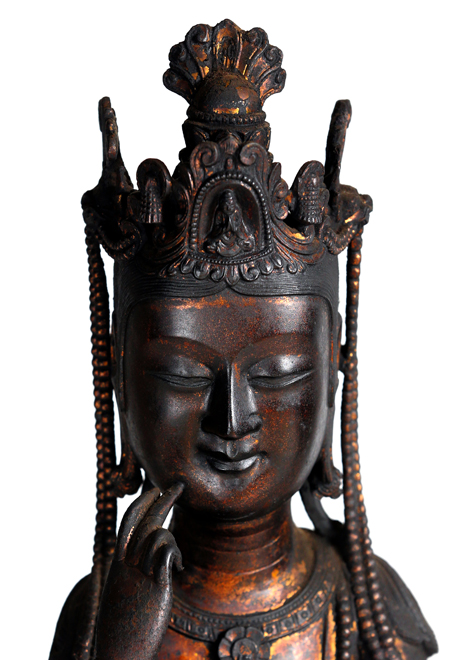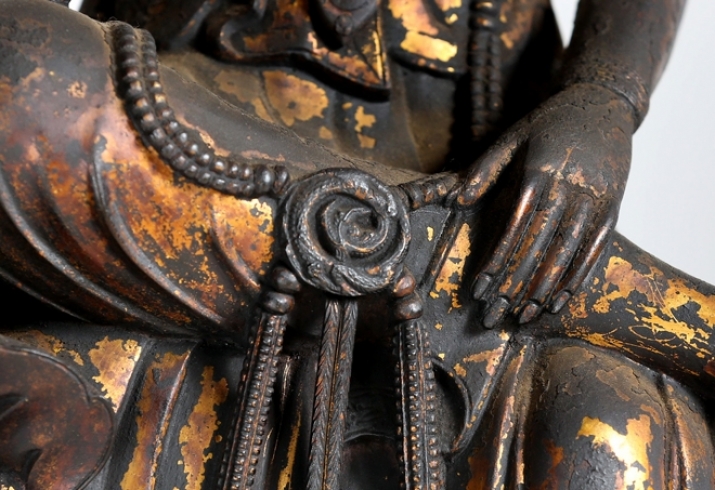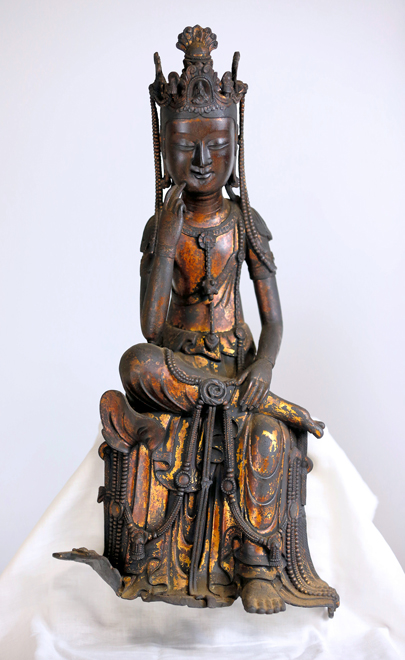NEWS
Bodhisattva Statue at Kyoto Temple May Be 1,000 Years Older than Previously Thought
Historians believe that a Buddhist statue kept at a small, 400-year-old Buddhist temple in the former Japanese capital of Kyoto may in fact be a priceless historical artifact that is some 1,000 years older than previously thought.
The 50-centimeter-tall metal sculpture of a seated bodhisattva known as “Hanka Shiizo”—the main statue at the neighborhood temple Myoden-ji in Kyoto’s Sakyo Ward—was originally believed to be about the same age as the temple, which dates to 1616, during Japan’s Edo period. The Edo period (1603–1868), which was characterized by economic growth, a complex and strictly defined social structure, isolationist foreign policies, and active cultivation of artistic and intellectual pursuits.
“The decoration is very detailed and the Korean Peninsula is very likely where it came from,” said Yutaka Fujioka, 54, a professor of Oriental art history at Osaka University, who announced his discovery on 13 January. “This makes it a very valuable Buddhist statue.” (The Asahi Shimbun)
Professor Fujioka, 54, said the statue was most likely made on the Korean Peninsula during the 7th century before finding its way to Japan with the eastward spread of Buddhism across Asia. He noted that it was extremely rare to find examples of such sculptures in Japan. Prof. Fujioka and his team of historians have to date examined some 400 ancient Buddhist statues in China, Japan, and South Korea.

The statue's headdress matches similar artifacts produced on the Korean
Peninsula between the 6th and 7th centuries. Photo by Yoshiko Sato.
From asahi.com
The seated bodhisattva, depicted with its right leg lying across the left thigh, and with one hand resting against the chin as if in deep contemplation, bears several features in common with similar artifacts produced on the Korean Peninsula between the 6th and 7th centuries, including the figure’s headdress and horizontal carved hairline. The depiction of a finely worked dragon motif on the leg of the Buddhist statue is also characteristic of other works created in Korea during this period.
An X-ray fluorescence analysis revealed the composition of the sculpture to be 86 per cent copper and about 10 per cent tin—a higher level of tin than normally found in statues from Japan and China and also pointing to artifact’s Korean origins.
 The dragon motif on the leg of the statue is characteristic of similar artifacts from ancient Korea. Photo by Yoshiko Sato. From asahi.com
The dragon motif on the leg of the statue is characteristic of similar artifacts from ancient Korea. Photo by Yoshiko Sato. From asahi.comIn light of the revelation of the sculpture’s value, the monastics at Myoden-ji have decided to store the statue at a museum for safekeeping. In its place, the temple will rely on a replica of the ancient artifact made with 3D printer. Myoden-ji is a Nichiren Buddhist temple founded by the monk Nichii, who converted from the Tendai school to Nichiren.
See more
Buddist statue in Kyoto may be a masterpiece from 7th century (The Asahi Shimbun)
Related news from Buddhistdoor Global
Archaeologists Puzzled by Ancient Roman Coins Discovered in Ruins of Japanese Castle
Portland Art Museum to Repatriate Rare Buddhist Painting to Korea
MFA Boston Exhibits Conservation of Rare 18th Century Buddhist Scroll Painting
Korean Museums Hold Art Exhibitions to Mark the Birth of the Buddha
Asia Society Holds Landmark Exhibition of Sculptures from Japan’s Kamakura Period in NYC
Korean Archaeologists Unearth Rare 9th Century Buddha Statue
Related features from Buddhistdoor Global
How to Read Japanese Buddhist Texts?
Cosmic Contemplations: A Glimpse of Japan’s Rare Star Mandalas
Visions from the Zen Mind: Zen Paintings and Calligraphy at the Los Angeles County Museum of Art
Beauty and Sadness: Reflections on a Japanese Noh Play
Seon and the City
“The Great Light of Compassion” (大慈悲光明) Expressed in Goryeo Water-moon Avalokiteshvara Paintings
Devout Patrons of Buddhist Art – Exhibition Review















